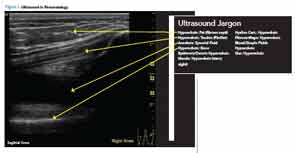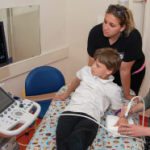My patient gladly let me scan his hands to see whether he had responded to treatment (sadly, he rarely did). He was fascinated whenever I froze those confusing black, grey and white lines and shadows on the screen. I tried to explain what each of these meant. Rather quickly, I realized that negative scans may be as important as those grossly positive, allowing me to redirect the focus of my care and move forward. My patient encouraged me to pursue this technique and provided me the opportunity to figure out for myself the logistics of whether and how to use MSUS, and how to interact with the patient and staff during the MSUS visit. I moved out of the knowledge-acquisition twilight zone and into the realm of the advanced learner.
My patient’s keen approach toward the US was not an isolated response. Many of my VA patients thought MSUS was cool. Although I usually had just enough time to perform focused joint exams, patients often requested that I scan additional joints during the future visits. At their request, and when appropriate, I visualized fluid pockets in knees, placed the needle and the steroids in the exact joint spaces, and analyzed the presence or absence of the tissue inflammation.
I think that such positive feedback is an important aspect of patient-centered medicine. Indeed, some have argued that patient satisfaction is often indicative of the quality of patient care.1 (Editor’s note: See Speak Out Rheumatology)
Challenges to Using US in Rheumatology
It has been observed that rheumatology fellows and those in practice for less than five years are those caregivers most interested in learning MSUS technique.2 But my mentor, David Minna, MD, of Dallas, is a stark exception to this rule. He didn’t get interested in MSUS until about 25 years into his career. He liked performing procedures and was intrigued by the early challenges of US: the technical aspect of its use, learning how to incorporate US into a busy practice and determining how best to finance this new but expensive professional tool. Finding teachers on how to use and apply ultrasound in rheumatology was a challenge, and a considerable part of his learning curve was based on self study.
Based on a 2010 fellowship program directors survey, less than half of the programs had a faculty member who was performing US in their practices.3 Perhaps the greatest challenge to expanding MSUS in rheumatologic care, besides lack of education and equipment cost/availability issues, is convincing colleagues to break the habit of referring many of their patients to radiology for more costly imaging. How will we succeed? Changing medical culture is never easy, but rheumatology fellows should have access to MSUS during their training. Not only can it help establish specific diagnoses, the technique also requires the student to know the relevant musculoskeletal anatomy. This knowledge can only help us in the management of our patients with rheumatologic diseases.

